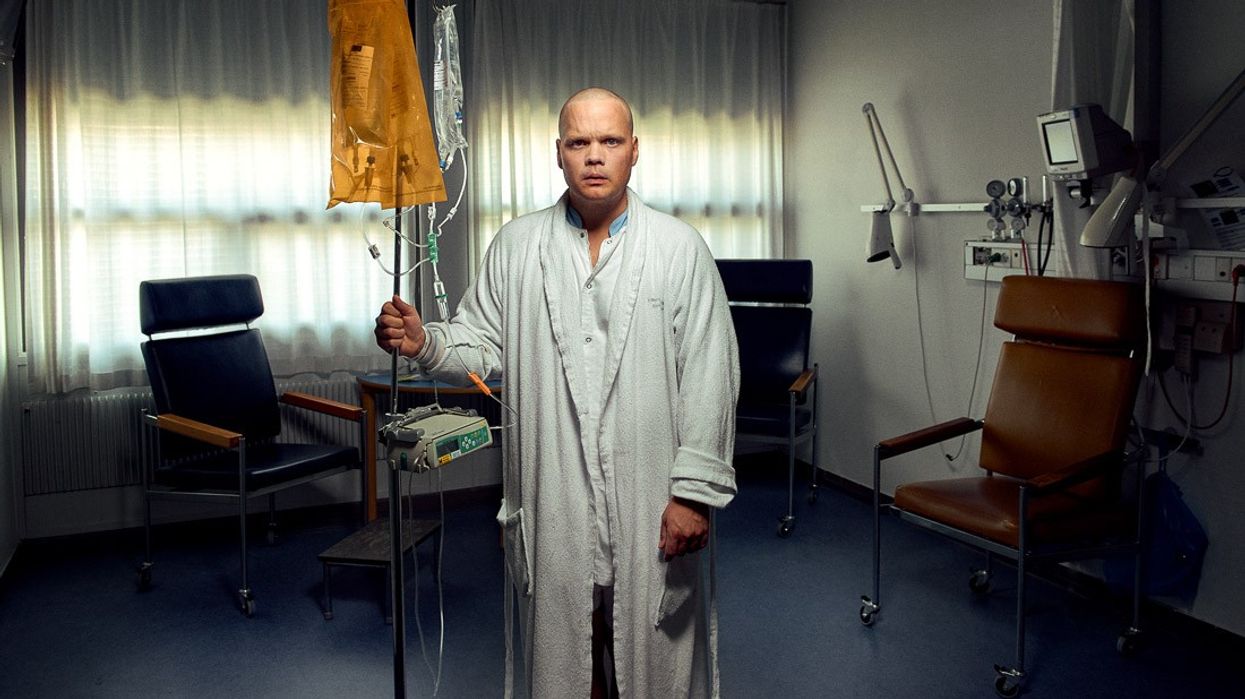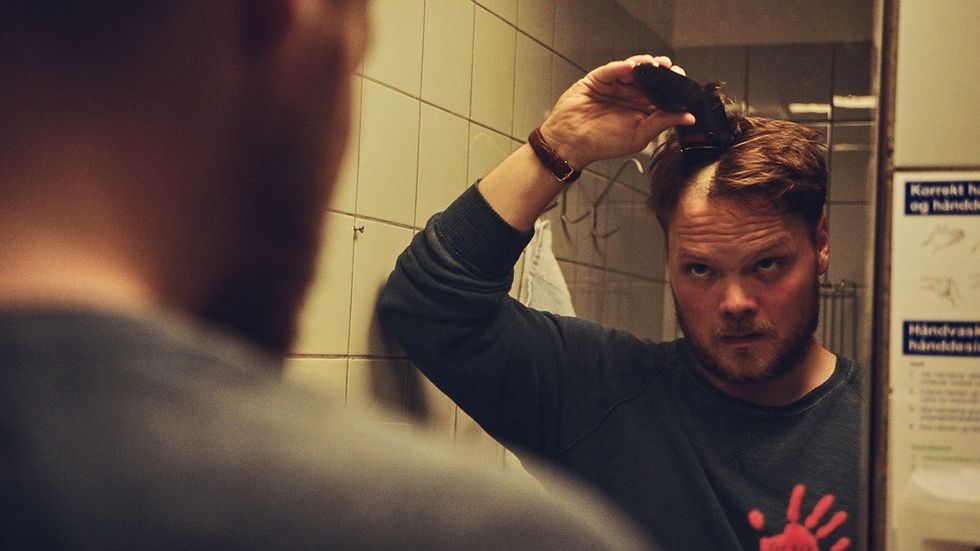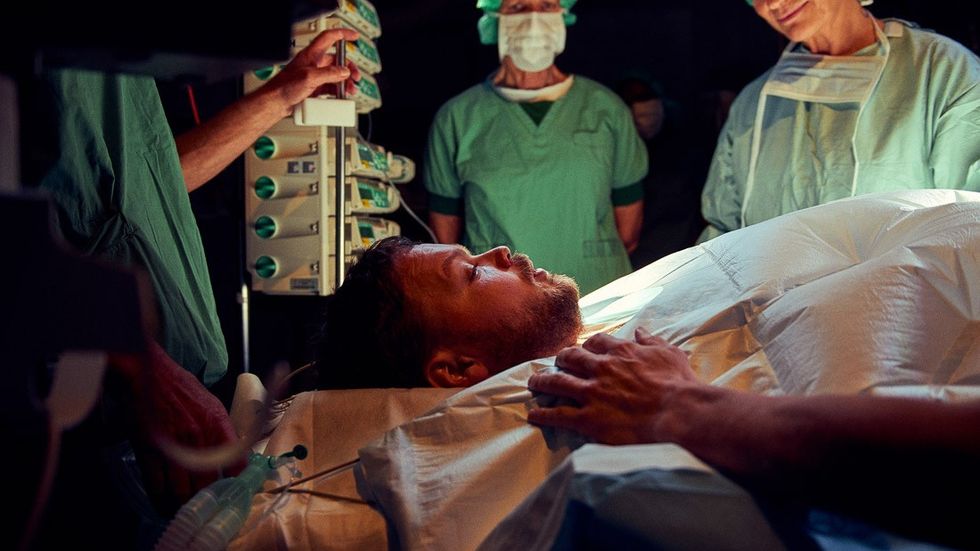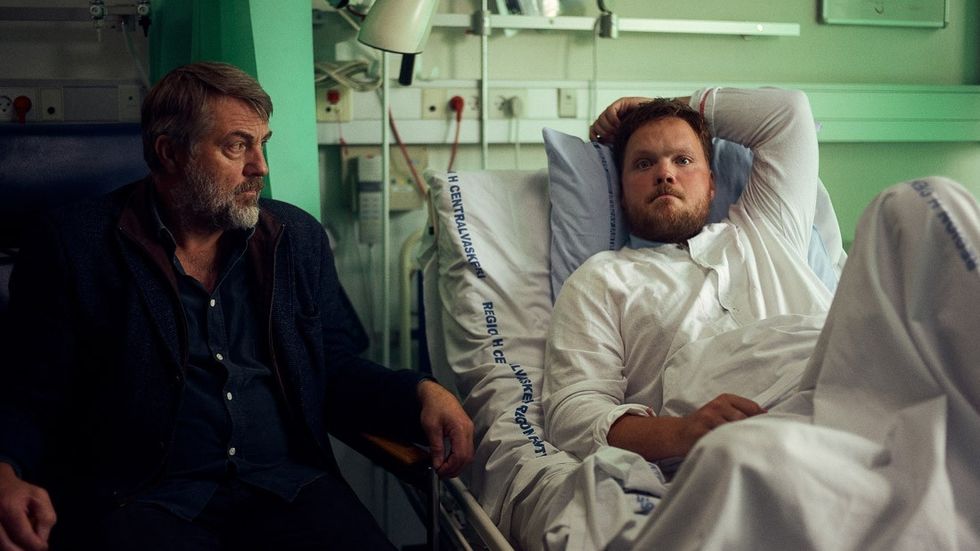'Chemo Brain': The Sundance Series Shot in 8 Days While in Alternative Film School
Kristian Håskjold shot his Indie Episodic premiere while still a film student and submitted it blind to Sundance.

In Chemo Brain, Kristian Håskjold's Sundance premiere, 28-year-old Oliver's (Adam Ild Rohweder) life turns upside-down when he receives a diagnosis of prostate cancer. He's forced to trade his carefree, youthful existence for hospital purgatory—a place that feels as if between life and death, where he receives chemotherapy and is intermittently visited by friends and family. Although everyone tries to keep things light (including Oliver himself), moments of levity are punctuated by confusion, anxiety, and ultimately, an emotional reckoning. Chemo Brain is an authentic window into a nightmarish experience, told with subtlety, relatability, and grace.
The 78-minute series, comprised of five episodes, first aired on Danish television. Håskjold shot it while still in film school. No Film School sat down with Håskjold before the series' Sundance premiere to discuss how he shot Chemo Brain in eight days (and edited it in three), what he learned from the rushed production experience, and more.
No Film School: You go to an alternative film school. Tell me about it! How does it work?
Kristian Håskjold: The school is called Super 16. it's an independent school, where six directors, six producers, and four writers are accepted every other year. We're the only staff—there's no dean or anything. We [the students] have a board with a chairman and everything. I'm the vice president.
NFS: Amazing. So it's like a co-op.
Håskjold: Exactly. The whole idea is that everybody's helping to do everything. But, of course, there is a person who's the head of public relations, and a person who's trying to set the direction for the school and so on. We have all different kinds of responsibilities.
You attend the school for three years, and you make a film every year. It's all funded by money from foundations and so on. We apply to these grants ourselves. Some years are better than others [financially]. The money goes into the production budgets and hiring teachers.
NFS: Do you run the admissions process?
Håskjold: Yes! People send in several films and test footage. You spend a lot of time [reviewing] applications while you're in your second year.
Everybody's working while in school. That's the whole idea: you're learning how to make films while you're in the industry and you get to educate yourself while working. When you finish school, you have already done a lot of productions, both for school and not for school. So you more or less just continue working when you graduate.
NFS: How did Chemo Brain come about, and where did it fit into all of this?
Håskjold: I did Chemo Brain on the side. Johan Wang, who I wrote the script with, contacted me back in July 2018 to tell me about his friend who had testicular cancer. He just thought it was a really amazing story because he's a character who deals with all the hard things with love and humor. This guy had written so many articles and posts about this whole process of having cancer—all the treatments, and his time in the hospital, and his friends and family and so on. Johan had just started at this new production company and asked if I wanted to develop and write and direct a series with him.
I just was really moved by the story. You can't really compare these two things, but I dealt with anxiety some years back. It was really heavy. So I could really relate to the thought of feeling really healthy--you're more or less just living your life--and all of a sudden, something just happens, and it just changes your perspective.

Håskjold: Johan and I wrote the story and pitched it to TV2, a Danish TV station. They were interested in the project, and it ended up being a collaboration with them and the Danish Cancer Society. There was always someone reading our scripts and trying to make sure all the technical parts and emotional processes and tone felt real. And worked with doctors in Copenhagen hospitals to try to make it as accurate as possible.
NFS: The series doesn't look low-budget at all, but I know it was.
Håskjold: That's because we had really good people [on our crew]. We got a lot of favors. We shot the whole thing in eight days. That's 75 minutes of film! I would say normally, in Denmark, you would have six to eight weeks to do that for a low-budget feature. So, shooting this in eight days was insane.
NFS: How did you finagle it?
Håskjold: In the writing phase, we tried to write it so that we shot as much as possible at the hospital, and tried to figure out how to make it interesting to be at the same location.
It was a lot of pre-production. And the shoot was an insane plan. We were just really lucky that nothing went wrong. Just the slightest thing could have messed up the whole shoot. Also, Adam, the lead, was so good, and that was important because for several of the scenes, we only had time to do one take. He has done a lot of improvisational work before, so he was really good at just going with it.
The post-production was also insane. We had three days to edit each episode, including sound and music and everything.
"Shooting this in eight days was insane. I would never do this again. I don't think it's how it should be done, to be honest."
NFS: That's insane. How did you find collaborators who were willing to do that?
Håskjold: Big favors. Our composer and sound designer, Eddie Simonsen, is one of the veterans in the sound design industry. He has done a lot of Nicolas Winding Refn movies. Also, a lot of American movies. I did my second-year film at his studio. He honestly didn't really know how tight it was going to be when he said yes [to the project]. But he's just a really nice guy!
Overall, I would never do this again. I don't think it's how it should be done, to be honest. I did it because it was a big opportunity for me to make something that could go on TV. But it's not a process I think should be a standard.

NFS: How did you do that with the cinematography?
Håskjold: Well we, more or less, kind of just figured out with both the production designer, Eva. And the [inaudible 00:16:42] about what elements do we have. And Eva, she brought up the [inaudible 00:16:45], to make them green, to use that to change the lighting in the room. Depending on how sick he felt or his condition and his emotional state. Then, I guess, more or less, each scene we decided what directions to shoot. And then each time we really quick, just analyzed where are we? How can we make it a little bit different than the last time? And then we'd make decisions about the lighting, for instance with the [inaudible 00:17:28] to change it a little bit to show his process.
NFS: So a lot of shots are very close up on him and, that, I think, helps us kind of connect with his emotional journey in everything. Did you shot list everything very meticulously?
Håskjold: No. We had this concept that we'd always shoot the master shot first. And then we'd always just go close. So we had... it's all kind of changed when shooting, because we had this idea that we should be following a lot more around. And then we shot a very alive camera. And we just figured out that if we didn't really feel right for the show. And we didn't really have any money to test these things out before. So just kind of figuring out when shooting. I guess we have talked all scenes through. We had ideas about what we needed to transition and so on. More or less, it was just mostly about doing the master shot, having a close camera that will follow him to get what we need.
But because it was so intense, we also just knew that a lot of the things are just going to happen as we go, and we just had to communicate really well together.
NFS: What did you learn about directing, in general, through this crazy, low budget, really tight shooting schedule?
Håskjold: It was actually a quite big experience for me because the last projects I've done at the school, we mainly didn't use any dialogue from the script at all. In my second year of film, we didn't write any dialogue. In this project it was having lines, being able to actually see the shot, and hear, what do I believe? What do I not believe? And then change it for the next take and adjusted it.
I lived out of editing. I think a lot of it is, as well, is to see what I feel I've learned
to think in editing. So I'm looking for the bits, when I see them, I can use. I tend to always be able to see if something is intertwining. Or messing it up, and you have to do it again.
NFS: You have to think like an editor.
Håskjold: But of course, you always get surprised when you get back and there are some things that are different when you see it in the editing suite, than when you were on set.

NFS: What are you doing here at Sundance? Are you going to take meetings for projects?
Håskjold: I'm meeting with one agent, which I'm really excited about.
NFS: A U.S. agent?
Håskjold: Yeah. He has some name directors!
Also, the industry here is different from Denmark. Denmark is so small. So I'm meeting with someone who does TV packages sales to teach me about how that stuff works here.
We're doing an interview with Avid later. So that's exciting. I think they're going to go crazy when they hear we edited the series in three to four days.
NFS: Did you find any shortcuts to editing that quickly?
Håskjold: I think it was just managing time. We had two editing stations. It wouldn't have been possible otherwise.
I pre-cut an outline first, and then we just went over it. We kind of threw it back and forth and sat with it and so on.
NFS: Did you have any idea that you would get into Sundance?
Håskjold: No, we were joking about it, because I haven't ever had a film here at Sundance before, and I've only directed short films.
NFS: You just sent the series in blind?
Håskjold: I sent it in a month after the deadline. I had been communicating with them before about the screenwriting labs and so on. And so I had a contact. I just emailed him asking if it be okay to send this in 30 days past the deadline. He just said, "Yeah, sure." I honestly did not expect to get in. We were all insanely excited.
For more, see our ongoing list of coverage of the 2020 Sundance Film Festival.
No Film School's podcast and editorial coverage of the 2020 Sundance Film Festival is sponsored by SmallHD : real-time confidence for creatives and by RØDE Microphones – The Choice of Today’s Creative Generation












